
The Role of Cable Tray Roll Formers in Modern Construction
In modern construction, the efficient organization and management of electrical wiring is crucial. One of the key components that aid in this task is the cable tray, which provides support and containment for electrical cables, telecommunications wiring, and other essential conduits. To produce cable trays in a cost-effective manner, many manufacturers are turning to cable tray roll formers—a technology that streamlines production while ensuring high-quality outputs.
What is a Cable Tray Roll Former?
A cable tray roll former is a specialized piece of machinery designed to create various types of cable trays through a process known as roll forming. This method involves feeding metal sheets, often made from materials like steel or aluminum, into a series of rollers that shape the sheet into the desired profile. The result is a precisely formed cable tray, which can be further processed or directly shipped to construction sites.
Advantages of Using Roll Forming Technology
The use of roll forming technology for cable trays offers several distinct advantages. Firstly, it allows for high-volume production, which is particularly beneficial for large-scale construction projects requiring multiple cable trays. The continuous feed process minimizes waste and reduces production costs significantly, leading to increased profitability for manufacturers.
Secondly, roll forming is highly versatile. With the right set of rollers, manufacturers can produce various sizes and shapes of cable trays, including ladder racks, troughs, and solid-bottom trays. This adaptability ensures that manufacturers can meet diverse customer requirements without needing entirely new machinery for each product variation.
Another significant advantage is precision. Cable trays must meet strict engineering standards to ensure safety and reliability. Roll forming machines can produce parts with tight tolerances, ensuring that each tray fits perfectly into the designated installation space. This precision reduces installation time and minimizes the risk of errors during the assembly process.
The Production Process

The production process using cable tray roll formers typically involves several steps. Initially, a coil of metal sheet is loaded into the roll former. As the metal passes through the machine, it is formed into the desired profile using a series of rollers, each progressively shaping the sheet.
Once the cable tray is formed, it can be cut to length using an integrated cutting mechanism. Additional processes, such as punching holes for mounting hardware or adding perforations for ventilation, can also be incorporated into the roll former, further enhancing production efficiency.
Maintenance and Upkeep
Like any piece of industrial machinery, cable tray roll formers require regular maintenance to ensure optimal performance. Routine checks and maintenance of the rollers, lubrication of moving parts, and alignment adjustments are crucial to prolonging the machine's lifespan and maintaining the quality of the produced trays. Proper training for machine operators is also essential to minimize downtime and ensure safety during the operation.
Future Trends in Cable Tray Production
As technology continues to advance, the future of cable tray production looks promising. Innovations such as automated roll forming systems, smart sensors for real-time monitoring, and enhanced software for design and workflow management are set to improve efficiency further. Additionally, as environmental concerns grow, more manufacturers are exploring sustainable materials and practices, and roll forming can easily adapt to these changes, allowing for the use of recycled materials and energy-efficient processes.
Conclusion
Cable tray roll formers play a pivotal role in modern construction, providing architects and builders with reliable, cost-effective solutions for managing electrical cabling. With their benefits including high production efficiency, versatility in design, and precision manufacturing, roll formers are set to be a fundamental part of the industry’s future. As technology progresses, these machines will only become more advanced, ensuring that the production of cable trays meets the increasing demands of the construction world.